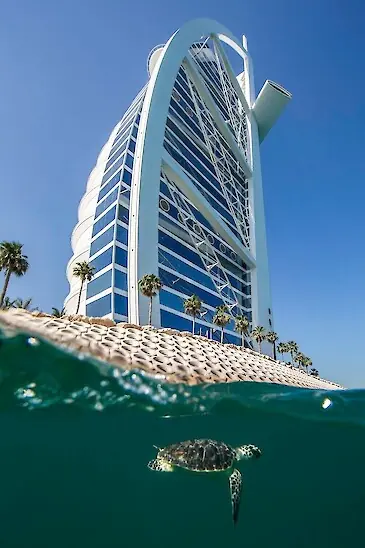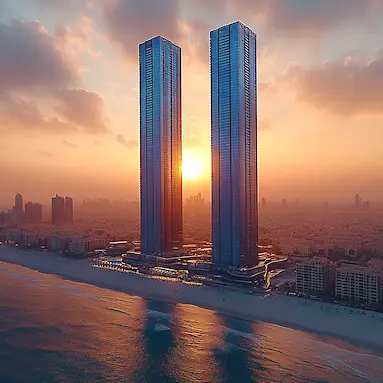We debunk Dubai's main legend. We take a behind-the-scenes look at Burj Al Arab and reveal how to step into a world of gold and butlers, even if you don’t own your own Rolls-Royce. ---
Dubai is a city where the boldest ambitions take shape from glass and steel, and the concept of luxury constantly strives for new, unattainable heights. In the lexicon of any seasoned traveler, this metropolis is firmly associated with a unique term—“seven-star hotel.” This phrase instantly conjures images of absolute splendor and service that surpasses all imaginable limits. But what really lies behind this grand title? Is it an officially assigned category or a brilliant marketing move that has become a true urban legend? In this article, we’ll conduct our own investigation. We’ll separate fact from fiction, peek behind the gilded doors of the world’s most famous “seven-star” hotel—Burj Al Arab—and, most importantly, provide practical advice on how every traveler can experience this extraordinary level of service firsthand.
Burj Al Arab Jumeirah: An icon that defined the concept of "7 Stars"
Forget about everyone else. In the world of “seven-star” luxury, there’s only one king, and his name is Burj Al Arab. This building is less of a hotel and more of a monument to human ambition, as well as the most iconic symbol of modern Dubai. It was Burj Al Arab that gave rise to and cemented this unofficial yet globally recognized status.
Architecture and design: a sail reaching toward the future
The foundation of the Burj Al Arab legend was laid during the design phase. Its uniqueness begins with its location—a hotel built on an artificial island 280 meters from the shore, instantly creating a sense of complete exclusivity and seclusion. The iconic shape, echoing the silhouette of a traditional Arab dhow sailboat, has become one of the most recognizable silhouettes in the world. And inside... Guests are greeted by the world's tallest atrium, soaring 180 meters into the sky. The interiors here are a hymn to opulence in the best possible sense. Imagine walking on Statuario marble—the very same material Michelangelo used to carve his "David." And everywhere you look, everything gleams—not with paint, but with nearly 1,800 square meters of genuine 24-karat gold, covering everything from columns to door handles.

Service deyond imagination
Yet even the most ostentatious luxury would merely be a gilded cage without the key ingredient—service. And this is where the Burj Al Arab pulls off its greatest feat. Forget five-star service; here, they operate on a completely different level, where hospitality borders on telepathy. Guests are greeted by their own fleet of pristine white Rolls-Royce cars for transfers, and for those who prefer traveling by air, there’s a helipad equipped on the rooftop. The hotel features just 202 suites, each of which is a two-level space. Check-in doesn’t take place at a common reception desk but directly in your room, in an atmosphere of complete comfort. The main highlight of the service is a personal butler assigned to each suite, available 24/7 to fulfill absolutely any request. It’s precisely in such details that the qualitative leap from excellent to extraordinary lies.
The philosophy of hospitality: A key principle at Burj Al Arab is anticipating the guest’s desires. From a menu featuring 17 types of pillows to ensure a perfect sleep, to a personal shopping assistant—here they strive to fulfill every whim even before it’s voiced.
World-class gastronomy: from the depths of the sea to the skies
Gastronomic experiences at Burj Al Arab are not just dinner—they’re full-fledged attractions that uphold its status as “more than just a hotel.” The most famous of these is Al Mahara (“Oyster Shell”), where you descend via an elevator designed to resemble a submarine. Its walls are a giant aquarium stretching from floor to ceiling, creating the complete illusion of dining at the bottom of the Persian Gulf surrounded by thousands of marine creatures. At the other extreme is the restaurant Al Muntaha (“The Ultimate”), perched on the 27th floor at a height of 200 meters. From here, you can enjoy breathtaking panoramic views of Dubai, turning dinner into a truly unforgettable experience.

What does "7 Stars" actually mean? A comparative analysis
Let's clarify: there is no official hotel classification system above five stars. The term "seven-star" isn't a formal rating but rather a set of characteristics that elevate a hotel far beyond standard notions of luxury. To understand this gap between "excellent" and "beyond exceptional," let's compare them head-to-head.
Interesting fact: officially, there is no hotel classification system above 5 stars in the world. The term "7 stars" was coined by a British journalist who, after visiting Burj Al Arab, simply couldn't find other words to describe a level of luxury surpassing all standards she had ever known.
- Privacy. At the best five-star hotel, you'll be offered access to a club lounge. At Burj Al Arab, you'll be provided with an entire private island complete with its own bridge, and check-in will take place in your suite while you sip a welcome juice. You might not encounter a single staff member in the corridors—separate entrances are provided for them.
- Personalization. An outstanding concierge at a 5-star hotel will remember what kind of coffee you drink. A personal butler at Burj Al Arab (available 24/7) will know which of the 17 (!) pillows from the special menu you'll choose tonight, and will arrange a personal shopping assistant for you at Dubai Mall.
- Material embodiment. In the luxurious 5-star hotel, you'll find miniature versions of cosmetics from a renowned brand. In the Burj Al Arab suite, full-size bottles of Hermès perfume for the whole family await you. And yes, that gold on the faucets is real.
Warning: Beware of fakes! Dubai has many luxury hotels, but some try to capitalize on the term "7 stars." Remember: the genuine, historically established unofficial status belongs exclusively to Burj Al Arab. Everything else is just marketing.
Planning your visit: How to experience the legend of Burj Al Arab
Contrary to popular belief, the hotel isn't accessible only to its guests. There are several ways to get inside, and your choice depends on your purpose and budget. We've prepared a guide to options for foodies, panorama enthusiasts, and those who want to uncover all the hotel's secrets.
Option 1: Through dining
Booking a table at one of the restaurants or lounges is the most popular and relatively affordable way to visit the hotel. To get acquainted with the atmosphere and the majestic atrium, the Sahn Eddar lounge, which serves the famous afternoon tea, is ideal. If your goal is a dinner with an unforgettable view, choose the Al Muntaha restaurant on the 27th floor.
A couple of important points: Don't try to drop by spontaneously—reservations must be made well in advance, sometimes several weeks ahead. You'll almost certainly be asked to pay a deposit, and yes, the dress code here is no joke—it's strict.
Budget tip: Consider the business lunch on weekdays. It's a great opportunity to enjoy the atmosphere and fine dining at the hotel at a more reasonable price than dinner or the popular Friday brunch.
Option 2: Over a glass on the 27th floor
The Skyview Bar, located next to the Al Muntaha restaurant, is the perfect spot to enjoy panoramic views of Dubai at night with a signature cocktail in hand. The atmosphere here is more relaxed than in the restaurant, yet equally refined.
A couple of important points: The bar has a minimum spend policy per person, so be prepared to spend a certain amount. The dress code is just as strict, and making a reservation in advance is absolutely essential.
Option 3: Through the front door (and the royal suite)
For those who want to see more than what's available to restaurant visitors, there's an exclusive guided tour. The "Inside Burj Al Arab" tour allows you to enter interiors hidden from public view, including the famous Royal Suite, and learn firsthand about the history behind this architectural marvel.
A couple of important points: Tickets are best booked through the official tour website. You can also clarify the current cost and duration of the tour there, which usually lasts about 90 minutes.
Dress code and etiquette: what you need to know before your visit
A strict dress code—"Smart Elegant" or "Smart Casual"—is enforced in all public areas of Burj Al Arab. This means your appearance should be neat and elegant.
What is not allowed: beachwear, shorts (for both men and women), flip-flops, open-toed beach shoes, and sportswear. Men are advised to wear long trousers, a collared shirt or polo, and closed-toe shoes. For women, an elegant dress, a skirt with a blouse, or a stylish pantsuit would be ideal.
Myth or reality?
So, is it myth or reality? Both. The "7 stars" are certainly a brilliant myth, a marketing ploy that forever changed the game. But Burj Al Arab achieved the impossible: it brought this myth to life with such grandeur that it surpassed even the boldest fantasies. It didn't just earn 7 stars—it created them from scratch. That's why a visit here isn't just a hotel stay; it's a pilgrimage to a monument of ambition, where you can literally touch the legend. Choose your own way, pick out your best outfit, and go—not just for luxury, but for the feeling that the impossible is indeed possible. At least for one evening.























Comments